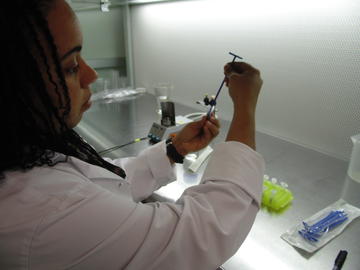2013
Two project partners (IDIAF, INISAV) were hosted at CIRAD laboratories, in Guadeloupe and in Montpellier. CIRAD's scientists went to Cuba to study the impact of cropping black Sigatoka tolerant banana varieties on the fungus that causes the disease.
Stay of R.T. Martinez (IDIAF) at CIRAD Guadeloupe
Reina Teresa Martinez, Cabaré project coordinator for the Dominican Republic (IDIAF), was hosted at CIRAD Guadeloupe from 28 October to 21 December 2013 as part of the third year of her PhD studies. Her research is focused on assessing the risk of dispersal of the banana streak virus (BSV) through the dissemination of interspecific banana and plantain hybrids bearing endogenous infectious BSV sequences.
Schemes to develop new banana varieties use two parents, Musa acuminata (A) and Musa balbisiana (B), to obtain interspecific triploid (AAB) or tetraploid (AAAB) hybrid varieties. However, M. balbisiana parents host endogenous banana streak virus sequences (eBSV) in their genome. Some of these sequences are infectious and can be expressed following biotic or abiotic stress, leading to plant infection. The thesis of R.T. Martinez is focused on assessing, on a field scale and via multilocation trials, the risk of BSV dispersal through the dissemination of interspecific banana and plantain hybrids bearing infectious endogenous BSV sequences.
This was Térésa’s second stay in Guadeloupe. In 2012, she had already stayed for 2 months (September-November) when she began an analysis of samples of FHIA-21 (AAAB) and Macho x Hembra (AAB) banana hybrids that had been collected in the main Dominican banana growing provinces. The aim was to determine the BSV prevalence and diversity in the Dominican Republic.
During her 2013 stay, she carried out more in-depth analyses on new samples collected in Montecristi and Puerto Plata provinces: “I am currently working on these samples and particularly on the characterization of endogenous BSV sequences (eBSVs) present in the Musa balbisiana genome. We know that infectious eBSVs can be expressed following stress. As Dominican banana producers plant this hybrid in high quantity, it is very important to be aware of the potential virus dissemination risk from this hybrid. I would like to thank my colleagues Luis Miniere and Domingo Reginfo who helped me in the sample collection.”
R.T. Martinez is registered in the third year of a PhD programme at the University of the French West Indies and Guiana (UAG). Her second dissertation committee meeting was held on 12 December 2013. The thesis supervisors are Graciela Godoy (IDIAF) and Pierre-Yves Teycheney (CIRAD), with Silvina Gonzalez-Rizzo (UAG), Marie-Line Iskra-Caruana (CIRAD Montpellier) and Damien Meyer (CIRAD Guadeloupe) being committee members
Mission of C. Abadie, J. Carlier and M-F. Zapater (CIRAD) in Cuba and participation in the INIVIT Symposium
C. Abadie, J. Carlier and M-F. Zapater (CIRAD) were in Cuba from 15 to 21 October 2013 to study the impact of cropping black Sigatoka tolerant banana varieties on the fungus that causes the disease. They sampled banana leaves at three sites that had previously been analysed in 2011 (Villa Clara, Mantanzas and Ciego de Avila) and at three new sites (Artemis, Cienfuegos and Sancti Spiritus).
Stay of Yanetsy Montero (INISAV) at CIRAD Montpellier (France).
From 12 September to 11 December, Yanetsy Montero Sanchez, agronomist at INISAV (Cuba), a project partner, was hosted at the CIRAD Montpellier laboratories. During her stay, she studied the evolution potential of the black Sigatoka causal agent, Mycosphaerella fijiensis, through an analysis of banana leaf samples collected in Cuba. These studies were carried out as part of research on the sustainability of resistance of hybrid banana varieties to black Sigatoka.
Following this stay, Yanetsy plans to use the same techniques in Cuba to analyse new samples collected in Cuba in late 2013.
Published: 12/03/2014


